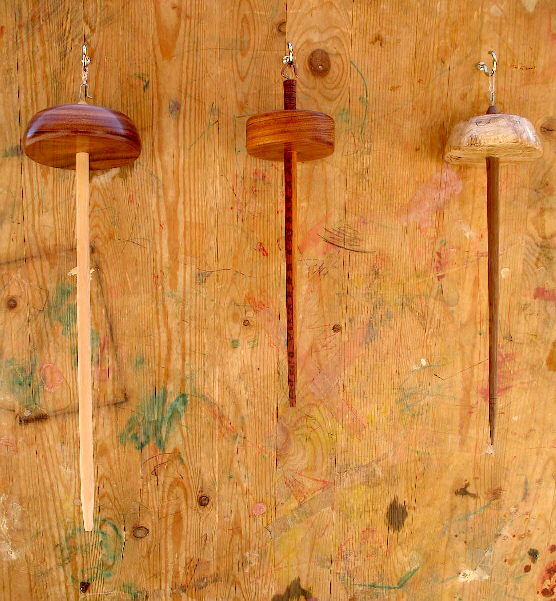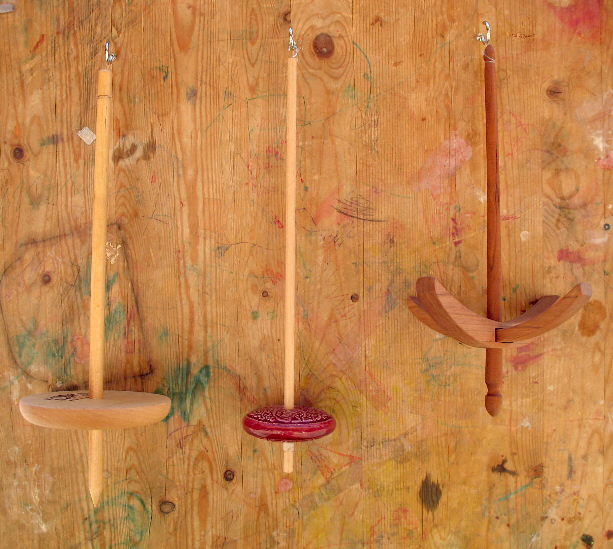 |
|
By Rebecca Hermen
|
|
 |
| Schacht, Grafton Mala,
Ann Grout, Bosworth, Turkish, Cascade St. Helens |
So you've decided to spindle
spin. Now what? You need a spindle. Not
just any spindle -- a spindle that you will love and
that will inspire you to learn something new. There
are a lot of different spindles to choose from.
How do you pick? What do all of these words mean?
Drop spindle? Hand spindle? Top whorl? Bottom
whorl? What's a whorl? Takhli? What about
all the different woods? What about the weight?
At the very basic there
are three types of spindle: top whorl, bottom
whorl and supported. The whorl is the disk
or ball that provides the weight to keep the spin
going. All three types are hand spindles.
Top and bottom whorl are both types of drop or
hand spindles. Drop spindles can spin almost
any fiber you want from dog hair to flax to wool
to Ingeo to silk.
 |
| Top whorl
spindles: Bosworth midi, Grafton Mala, Cascade
St. Helens |
It has a hook on one end
above the whorl and a shaft below the whorl for storing
your finished yarn.
Top whorl spindles can come in
many weights and sizes. Top whorl spindles usually spin
faster and quite often are lighter than their bottom
whorl counterparts. They are great for very fine,
lace weight yarns. They also usually are quicker
to load since they have no need of wrapping or half-hitching
to keep your yarn on the spindle.
 |
| Bottom
whorl spindles: Schacht, Anne Grout, turkish |
A bottom whorl spindle usually
just has a shaft and a whorl, sometimes a hook and sometimes
not. Finished yarn is stored above the whorl.
To keep the yarn on the spindle, you usually have to
do some wrapping and half-hitching.
Bottom whorl spindles also come
in various sizes. Bottom whorl spindles are usually
less bouncy, spin longer and are better for plying yarns
on than top whorl spindles.
Of course, you can find rabid
advocates of either top whorl or bottom whorl spindles.
Just like you can rabid advocates of various types of
spinning wheels, fibers, yarns or knitting needles.
Your best bet is to take a few spindles for a test drive
and decide what you like.
Supported spindles are less common
in both availability and usage. They can have
hooks or not. They can have bead whorls or flat
whorls. One end of a supported spindle sits in a bowl
or some other shallow container and the working end
hangs free. The spindle is spun and twist builds
up in the yarn. The spindle is stopped and the twist
is drafted out into the fiber. These types of
spindles are best for spinning very short fibers like
cotton or dryer lint or for spinning very fine.
A Takhli is a type of supported spindle.
Quick
reference to spindle weights.
Typically, the heavier the spindle, the
fatter the yarn it will spin.
| To
spin... |
your
spindle
should weigh... |
|
lace
|
.5
oz/15 gm |
| fingering |
1
oz/28gm |
| sport/DK |
1.75
oz/50gm |
| worsted |
2.5
oz/70 gm |
| bulky |
3
oz+/85gm |
|
So, you've decided what type
of spindle you want and you're looking at spindle ads.
They talk about featherweight, or .05 oz, or maxi, or
boat anchor. What are they talking about? It's
all about weight. The weight of your spindle to
a great extent dictates how thick, or heavy your yarn
can be. You can't spin lace weight yarn on a really
heavy spindle and you can't spin bulky yarn on a featherweight.
Starting out, unless you're really sure you are planning
on always making lace or super bulky hats or only plying
commercial yarns, you should choose a spindle that weights
somewhere between 1.75 to 2.5 oz. This is a nice
medium weight.
Okay, you decided on the
type. You've decided on the weight. What about
woods? There are hundreds of woods that spindles
are made of and a million combinations between
whorl and shaft. (I won't even mention the ceramic
or ploy clay varieties of spindles.) My advice
is check the weight, check the price -- make sure
both are in your range. Then let the spindle speak
to you. Which one is gorgeous? Which one would
you cry over if it goes home with someone else?
Now where to buy a spindle?
If you have the opportunity, go to a wool or fiber
festival where you get your fingers on a several spindles
and try them out. Or find a local spinning guild
and do the same thing. A spinning guild has
the advantage of usually having a "spindle person"
who can give you pointers on how to use your spindle.
You can also shop the web. You can find spindle
reviews, spindler mail lists and spindle vendors.
You can even find directions for making very inexpensive
spindles out of old CDs and dowel rods (http://www.interweave.com/spin/resources.asp
).
|
Obsess
much?
Here are some places to visit on the web
to feed your spindle frenzy
-
Spindlicity,
an online spindle spinning magazine
- Spindlitis
Yahoo group
- Spindlers
Yahoo group
|
| New
to spinning?
Or want
to get better at spinning with a spindle?
Practice as little
as 15 minutes every day. You'll be a spinning
maniac in a week.
|
Four (of the many) spindle
vendors on the web that are great at walking you
through your first spindle purchase are Bosworth Spindles and
Grafton
Fibers if you want to buy from the spindle
artist and The Bellwether and Carolina
Homespun if you want a vendor that sells a
variety of spindle artists.
You've bought your spindle and
starter fiber and they are staring you in the face.
Where to learn how to spindle? A few great books
are Spindle Spinning from Novice to Expert by
Connie Delaney, Spin It by Lee Raven and High
Whorling by Patricia Gibson-Roberts (out of print
but available at many spinning retailers and libraries).
This On the web try www.icanspin.com or the
(Spin off magazine website
) Or find one of those "spindle people"
at a spinning guild or spinning shop.
Pick up a spindle.
You'll be surprised how fun and relaxing it really
is. You might even start looking at your
knitting as sucking away your spindle time.
|
| |
|
  Rebecca supports her fiber
habit as a children's librarian in Dearborn, MI. A
long-time spindler, she finally broke down and bought
a wheel about 4 years ago and finally learned to knit
about 6 years ago. Her husband demanded she do something
with the yarn she was making.
Rebecca supports her fiber
habit as a children's librarian in Dearborn, MI. A
long-time spindler, she finally broke down and bought
a wheel about 4 years ago and finally learned to knit
about 6 years ago. Her husband demanded she do something
with the yarn she was making.
Rebecca still
packs a spindle almost everywhere she goes and can
be found addicting, um, instructing spindlers with
the Spinners' Flock in Chelsea, MI.
|
| text © 2006 Rebecca
Hermen, photos © 2006 Jillian Moreno. Contact Rebecca |
|

